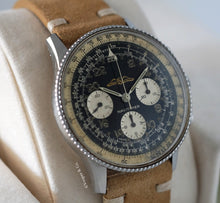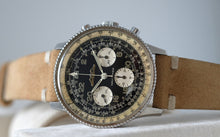
Breitling. An Early Stainless Steel Pilot’s Chronograph Wristwatch
Model: Cosmonaute Navitimer
Reference: 809
Circa: 1963
Venus Cal. 178 mechanical movement, 17 jewels, black dial, luminous baton and Arabic numerals for 24 hour indication, luminous hands, inner double time scale for MPH and KM, outer revolving slide rule on a silvered chapter ring, three silvered engine-turned subsidiary dials for 12 hour and 30 minute registers and constant seconds, large circular case, beads of rice bezel, extended down-turned lugs, two round chronograph buttons in the band, snap on back, case, dial, and movement signed.
Watch is freshly overhauled.
42mm
More about Breitling:
In the early 1950s, Breitling released their first pilot’s watch, the ref. 806. Featuring a slide rule chronograph and the AOPA (Aircraft Owners and Pilots Association) logo, the model was called the “Navitimer”.
In 1959, Scott Carpenter was selected to be one of the original seven Mercury Astronauts. During his time as a US Navy pilot, Carpenter wore a Breitling Navitimer, and after being selected for the space mission, contacted Breitling to ask for a 24-hour version of the Navitimer. The first version of the 24-hour Navitimer was introduced in 1961, and given the same 806 reference number and featured the AOPA logo on the dial. In July of 1961, Breitling registered the name “Cosmonaute” and began producing the 24-hour Navitimer as the reference 809, however the name “Cosmonaute” was not always used on the dial.
In February of 1962, Carpenter served as backup for John Glenn during preparation for America’s first manned space flight. Carpenter flew on the second American manned space flight a few months later, in May of 1962, having received his 24-hour Navitimer Cosmonaute a few days prior to taking off. Breitling used Carpenter’s successful space flight in their advertisements of the Cosmonaute, showing the same black dial/black subsidiary dials combination that Carpenter wore.
By the end of 1962, the reference 809 Cosmonaute was produced with a number of different dial signatures – some with “Cosmonaute”, some with “Navitimer”, some with the Breitling “B” logo and some with the AOPA logo. Between the end of 1962 and into 1963, Breitling began to update the dial, using silvered subdials to contrast with the black dial, and slimmer hands. By 1964, Breitling replaced the bezel, using a coin-edge instead of the “beads of rice”.
The present watch is an excellent example of an early reference 809, with a beautifully aged dial and desirable beads of rice bezel. The outer slide rule has developed a light golden patina, which contrasts nicely against the black dial, silvered subdials, and golden AOPA logo. Reference 809 Cosmonautes with the beads of rice bezel are highly sought after, having only been produced for less than two years. While the model was produced at the time for the specific purpose of being taken into space, its place in history and timeless design make it wearable today at any occasion.

















